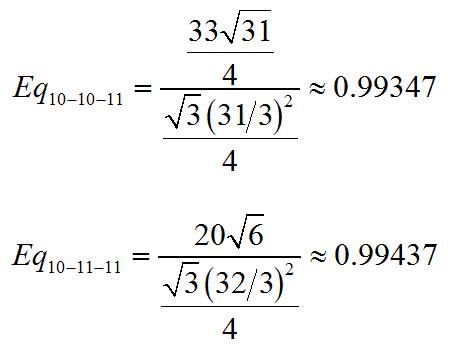Which Triangle is More Equilateral? Part II
 A surprising amount of interest was generated by my question “Which Triangle is More Equilateral?” With the passing of consecutive Isosceles Triangle days, I wondered: which triangle was more equilateral, the 10-10-11 triangle, or the 10-11-11 triangle?
A surprising amount of interest was generated by my question “Which Triangle is More Equilateral?” With the passing of consecutive Isosceles Triangle days, I wondered: which triangle was more equilateral, the 10-10-11 triangle, or the 10-11-11 triangle?
Many rich and interesting conversations arose as a result of this question. Colleagues, students, and commenters on the original post offered good ideas about how to approach both the question itself and the concept in general.
There is a lot to say about this seemingly simple problem, but I’ll begin by sharing my approach to the question “Which triangle is more equilateral?”
After playing around with several ideas, I tried to get to the heart of equilateralness. Equilateral is a well-defined idea (all sides congruent), but how could we relax that definition and quanitfy equilateralness in a continuous, rather than a discrete, way?
I chose to to think of equilateralness as a measure of how circle-like the object is: the more it’s like a circle, the more equilateral that object is. What does it mean to be circle-like? I chose the following idea as my foundation: the fundamental characteristic of the circle is that it maximizes area for a given perimeter. From that perspective, I created a measurement.
I define a triangle’s equilateralness to be the ratio of its area to the area of the equilateral triangle with the same perimeter. Thus, for triangle ABC with sides a, b, and c, its equilateralness is given by
where [ABC] denotes the area of triangle ABC.
Since the equlateral triangle is the triangle of maximum area for a given perimeter, the above measure will be bewtween 0 and 1 for all triangles. The closer its Eq is to 1 , the closer the triangle is to being equilateral.
So for the triangles in question, we have
Thus, by a very slim margin, the 10-11-11 triangle is more equilateral than the 10-10-11 triangle!
The value in this question is not so much settling on this, or any, particular approach; what’s valuable here is the opportunity to creatively explore a lot of interesting and deep mathematical ideas. I look forward to doing just that!
Related Posts
- Which Triangle is More Equilateral?
- Another Equilateral Comparison
- Which Triangle is More Equilateral? 2012 Edition
- An Ode to Equilateralism


9 Comments
student · October 15, 2011 at 3:01 pm
my brother said that there is a simpler way in doing this
if we have a 10-10-11 triangle it would need to be 10-10-10 to be equilateral
so the triangle would be 10% off from being equilateral
if we have a 10-11-11 triangle it would need to be 11-11-11 to be equilateral
so the triangle would be 1/11 ~ 9% off from being equilateral.
Therefore, the 10-11-11 triangle is “more equilateral”
MrHonner · October 15, 2011 at 3:17 pm
That’s an interesting approach. What conclusion would be reached if you compared a 9-10-11 triangle and a 9-11-11 triangle in this way?
student · October 15, 2011 at 9:11 pm
in response to that my brother said it would be the 9-11-11 triangle.
the 9-11-11 triangle would be 11-11-11 if it were equilateral. that makes the side of 9 to be 2/11 off from being equilateral.
the 9-10-11 triangle would be 10-10-10 if it were equilateral. that makes the side of 9 to be 1/10 off and the side of 11 to also be 1/10 off from being equilateral, adding up to be 2/10 off
that would make the 9-10-11 triangle more off from being equilateral than the 9-11-11 triangle
MrHonner · October 15, 2011 at 11:15 pm
So that’s what your brother thinks, but what do you think?
Intuitively I think the 9-10-11 triangle is more equilateral. Maybe I should run the above analysis on it and see if the result agrees with my intuition.
Ben · October 15, 2011 at 11:04 pm
This idea is entirely fleshed out but what about considering the minimum distance that a vertex would have to displace in order to “make” the triangle equilateral?
This idea kind of breaks down in the sense that a 17-17-16 triangle is just as “almost equilateral” as a 170-170-160 but I’m sure it can be fixed.
MrHonner · October 15, 2011 at 11:16 pm
That’s a good idea, too, but it gets complicated if you can most efficiently achieve an equilateral triangle by moving more than one vertex.
David Locke · August 31, 2014 at 11:25 am
Equilateral triangles will tile to a flat plane, so you are in Euclidean space. Any other triangle will either have a gap, or an overlap on a flat plane, so you are in hyperbolic space with the former, or spherical with the latter.
I’m sure there is some parameter of a space that describes the same classification scheme. You wouldn’t need the term equilateralness.
John Coleman · October 1, 2021 at 11:02 am
Nice, helpful post. I was able to use it in an answer on Stack Overflow:
https://stackoverflow.com/questions/69394529/find-out-which-triangle-is-closest-to-equilateral-triangle-fastest-simplest-way/69408066#69408066
MrHonner · October 1, 2021 at 8:52 pm
Cool! I’m glad it was helpful. Thanks so much for letting me know!